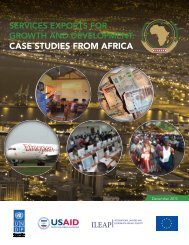BUDGET
budget
budget
Create successful ePaper yourself
Turn your PDF publications into a flip-book with our unique Google optimized e-Paper software.
26 MEETING OUR GREATEST CHALLENGES: INNOVATION TO FORGE A BETTER FUTURE<br />
in reducing carbon pollution and strengthening<br />
resilience to climate change.<br />
Assisting these countries in meeting emissions<br />
reduction commitments and developing<br />
their economies along low-emissions pathways<br />
would play a vital role in mitigating<br />
some of the most serious risks from climate<br />
change both at home and abroad. Assisting<br />
developing countries in their climate adaptation<br />
efforts is critical to helping the poorest<br />
and most vulnerable nations prepare for, and<br />
build resilience to, the impacts of climate<br />
change. These efforts would not only help preserve<br />
stability and security in fragile regions<br />
that are of strategic importance to the United<br />
States, but also help open these regions to U.S.<br />
businesses and investment.<br />
More broadly, GCCI funding enables the<br />
United States to provide international leadership<br />
through the Department of State, the<br />
U.S. Agency for International Development,<br />
and the Department of the Treasury to support<br />
our developing-country partners in their<br />
efforts to meet their emissions reduction commitments,<br />
including by expanding clean and<br />
efficient energy use, reducing deforestation<br />
and forest degradation, conserving the world’s<br />
remaining tropical rainforests, and phasing<br />
down the production and consumption of substances<br />
with high global warming potential,<br />
such as such as hydrofluorocarbons. GCCI<br />
funding would help support U.S. commitments<br />
made in the context of the Paris Agreement<br />
and put the United States on a pathway to<br />
doubling U.S. grant-based support for international<br />
climate adaptation activities by<br />
2020. Federal agencies will also systematically<br />
integrate climate-resilience considerations<br />
into international development investments<br />
so that U.S. investments overseas remain sustainable<br />
and durable and support the poorest<br />
and most vulnerable communities in their<br />
efforts to cope with the adverse impacts of<br />
extreme weather events and climate change.<br />
INVESTING IN RESEARCH AND DEVELOPMENT<br />
Because of the critical role that R&D<br />
plays in expanding the frontiers of human<br />
knowledge, tackling the Nation’s biggest challenges,<br />
and driving the economy forward, the<br />
Administration has consistently prioritized<br />
robust R&D investments since the start of the<br />
Administration.<br />
The Budget sustains the Administration’s<br />
consistent prioritization of R&D with an investment<br />
of $152 billion for R&D overall through<br />
both discretionary and mandatory funding<br />
proposals. This reflects a four percent increase<br />
from 2016 and targets resources to the creation<br />
of transformative knowledge and technologies<br />
that can benefit society and create the businesses<br />
and jobs of the future. Specifically, the<br />
Budget prioritizes basic research, the type of<br />
R&D that is the most likely to have spillover<br />
impacts to multiple endeavors and in which the<br />
private sector typically under-invests. It also<br />
includes $7.7 billion in discretionary funding<br />
for clean energy R&D in 2017, the first step toward<br />
the Mission Innovation doubling goal.<br />
Of the overall $152 billion investment in<br />
R&D, $4 billion is mandatory funding because<br />
the discretionary levels set by the Bipartisan<br />
Budget Act are not sufficient for the Nation<br />
to take full advantage of the opportunities for<br />
R&D investments to create jobs and grow the<br />
economy.<br />
Revitalizing American Manufacturing<br />
After a decade of decline, American manufacturing<br />
has added 878,000 new jobs since<br />
February 2010, new factories are once again<br />
opening their doors, and global investment in<br />
the U.S. manufacturing sector is increasing.<br />
The Budget proposes $2.0 billion in coordinated,<br />
cutting-edge manufacturing R&D, while also<br />
expanding industry-driven workforce training<br />
and providing additional resources through the




